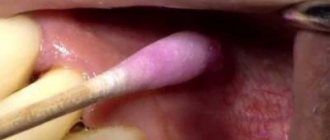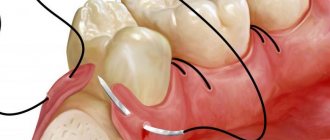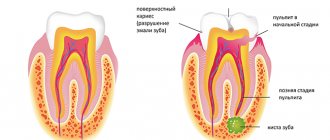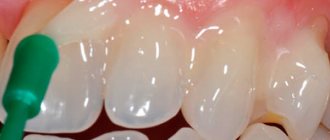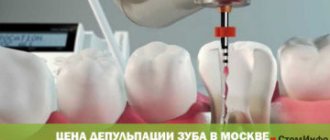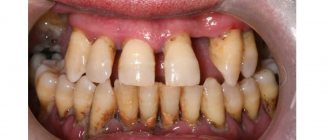17.11.2019
Many people mistakenly believe that a tooth is a completely bony structure. In fact, the dense shell is found only in the upper layers of the elements, and inside them there are nerve endings, represented by the pulp. Often, when the enamel is destroyed, the nerves also suffer, and in this case you have to urgently consult a doctor or try to reduce the unpleasant signs of the problem yourself. The causes of inflammation of the dental nerves and ways to combat the problem will be discussed in the article.
Functions of the dental nerve
Nerve fibers along with blood vessels are located in the soft core of the tooth - the pulp.
The pulp performs the following functions:
- nutrition of the entire tooth;
- mineralization of enamel and dentin;
- providing immunity.
If the nerve is lost, the crown of the tooth will remain, but will become very fragile due to the lack of blood supply and will cease to respond to external stimuli. The enamel will begin to crumble and may turn black. Such a tooth is called “dead”.
Why delete it?
Removal of the dental nerve is called depulpation. The pulp is an important part of the tooth, so they always try to preserve it at least partially.
Complete removal of the nerve is resorted to:
- to prevent the spread of the inflammatory process to healthy tissue during pulpitis;
- to relieve pain;
- to facilitate treatment of other dental tissues.
Important! The operation is required in cases where the pulp has undergone an inflammatory process and there is a risk of its further spread.
Why does it hurt
The pulp consists of 20% nerve endings, so it is very sensitive even to simple touches.
With pulpitis (inflammation of the dental nerve), accompanied by severe throbbing pain, the sensitivity of the dental nerve increases several times. Therefore, surgery in most cases is performed only with the use of anesthesia.
Dentist about nerve removal:
Indications for removal
Removed dental nerve
Indications for surgery are divided into therapeutic and orthopedic. Therapeutic indications include damage to the pulp itself. This:
- pulpitis;
- deep caries that has spread to the pulp chamber;
- development of periodontitis - inflammation of the tooth root;
- damage to the pulp by calculi - stones formed in the root canals of the tooth;
- severe mechanical trauma to the tooth affecting the pulp.
Depulpation may also be necessary for some types of prosthetics or crown installation.
Orthopedic indications for nerve removal:
- strong inclination of the tooth, which does not allow grinding under the crown without affecting the pulp chamber;
- low dental crown;
- risk of overheating and further inflammation of the pulp;
- pulp chamber is too large;
- the presence of deep caries on the tooth undergoing treatment.
In these cases, removal of the nerve is mandatory. In other situations, the decision about depulpation is made by the attending physician based on the individual characteristics of the patient.
Medications
You can kill the nerve in a tooth at home using pharmaceutical medications. To do this, you can use special dental pastes that do not contain arsenic. These include “Devit-P” and “Devit-S”. You need to brush your teeth well, clean the canals from food debris and put a pea of paste in the hollow, fix it with dental glue recommended for fixing dentures. All this can be easily purchased at any pharmacy, and it is safe for health.
When choosing pharmaceutical products that kill the dental nerve, you need to remember that some of them may contain arsenic, which can be harmful to health if used incorrectly. It is better to immediately check the composition of the drug with a pharmacist or read the instructions for it.
Is pulp removal necessary before installing crowns?
In the absence of absolute indications for nerve removal, it is usually preserved. In some cases, doctors perform pulp removal under the crown in order to avoid complications and be able to work more freely with the tissues of supporting teeth without fear of damaging the pulp. This approach has irreversible negative consequences:
- the tooth will be more susceptible to pathogenic effects;
- if the remaining coronal tissues are destroyed, it may be necessary to remove them;
- To perform the operation, it may be necessary to remove the pulp from adjacent healthy teeth.
Preserving the pulp will keep the remaining coronal portion alive. This is preferable to unnecessary surgical intervention, although it will require more precise and careful work from the orthopedist.
The risk of pulp inflammation after installation of a crown or prosthesis occurs when:
- development of oral diseases;
- decreased immunity;
- presence of chronic diseases.
In case of inflammation of the dental nerve under the prosthesis, it will have to be removed and depulped, after which a new one will be created and installed.
Video on the topic:
What complications can there be from home methods?
Even a doctor during depulpation can make a mistake that will lead to undesirable consequences. What can we say about independent attempts to kill the pulp at home, without following any rules of asepsis and antiseptics. Among the possible negative consequences of such arrogance, experts note nerve separation, severe hemorrhage due to vascular injury, as well as the spread of inflammation to nearby tissues. Other possible problems include:
- allergic reaction to the substances used,
- injury to healthy tissues,
- burn of the mucous membrane,
- loss of taste sensitivity,
- infection and sepsis.
When using home methods, a burn may occur.
Most often, after trying to kill the pulp on their own using traditional methods, patients are faced with a severe burn of the mucous membrane. In other cases, the pulp is burned with preservation but serious damage to the nerve.
Painfulness of the procedure
The pain of depulpation depends on several factors:
- degree of neglect of inflammation;
- nerve removal method;
- patient's pain threshold;
- the degree of proficiency in the technique of the doctor performing the operation.
Some patients prefer to go to private clinics to have surgery under anesthesia, but there are a number of contraindications to this. Modern means of anesthesia make it possible to reduce pain to a minimum, and the only inconvenience during the operation can be caused by the operation of the drill.
Important! The procedure will be as painless as possible only if you consult a doctor in a timely manner. When removing a nerve with advanced inflammation, it will not be possible to completely avoid pain.
When using arsenic
Arsenic paste
The procedure for adding arsenic is painless, provided that it is performed under anesthesia. The process of pulp death itself is accompanied by pain: the tooth becomes sensitive to temperature and reacts more sharply to mechanical irritation (friction, pressure), despite the fact that arsenic paste contains an anesthetic that partially relieves pain.
In addition to pulp tissue necrosis, pain can be caused by other reasons:
- inflammation of periodontal tissues;
- swelling of the nerve bundle;
- intoxication of the body.
Attention! If, in addition to pain in the crown itself, painful sensations occur in the jaw: this indicates the development of osteonecrosis - a serious complication after using arsenic paste. If you have this symptom, you should immediately consult a doctor and begin treatment.
Removal of the dead pulp itself is painless. Local anesthesia is used if the action of arsenic has caused inflammation of surrounding tissues.
When using anesthesia
In most cases, the nerve is removed under local anesthesia.
The most effective method of pain relief is injection. In this case, painful sensations are reduced to zero: before the injection, the gums are lubricated with an anesthetic spray or gel, and very thin needles are used for injection. The most popular drugs for local injective anesthesia:
- ultracaine or pure articaine;
- mepivacaine;
- articaine with epinephrine.
These remedies last longer and are suitable for allergy sufferers, people with severe chronic diseases, and pregnant women.
Placing lidocaine-based gels also allows you to completely numb the area around the affected tooth. With current anesthesia, the patient does not feel any discomfort. Pain can only occur if the injection is given incorrectly or the body’s sensitivity to the drugs is low.
Partial nerve removal, like complete removal, is performed under local anesthesia, and there is no pain during the procedure.
Without anesthesia
If the nerve is already dead, its removal will not cause much discomfort: only mechanical manipulation of the tooth will cause discomfort.
If the nerve is still alive, even the process of exposing it will cause pain, let alone removing it. The intensity of the pain syndrome in this case depends on the sensitivity of the patient and the professionalism of the doctor.
How to relieve pain at home yourself
It is worth taking a closer look at the question of how you can calm the nerve yourself before visiting a specialist. You need to understand that such remedies are only needed to mask the symptoms, but they will not help to quickly kill the pulp and relieve you of pain forever. Therefore, you will have to visit the dentist in any case. And if it is not possible to do this urgently, the following traditional medicine recipes will help to relieve the pain and discomfort a little:
- Soda-salt solution is one of the most popular and effective home remedies for relieving acute toothache. A teaspoon of salt and soda should be diluted in a glass of boiled water at room temperature and then used for rinsing the mouth,
You can use a solution of soda and salt - a solution based on 3% hydrogen peroxide also helps reduce the intensity of discomfort. Peroxide should be diluted in warm water in a ratio of 2 to 1, then soak a cotton swab in the resulting solution and apply it to the sore tooth,
- onion peels will help reduce pain and disinfect tissues. To do this, pour 500 ml of boiling water over a small handful of husks and leave for a while on low heat. Strain the finished broth, let it sit for 2-3 hours and then use it for rinsing,
- a mixture of garlic and salt will help reduce inflammation somewhat. To do this, it is placed in an open carious cavity,
- Clove essential oil has pronounced antiseptic and anti-inflammatory properties. It is enough to drop a couple of drops on a cotton swab and cover the painful area with it,
- herbal decoctions of chamomile, mint, lemon balm, thyme, sage and oak bark. You can prepare a decoction of herbal tea or use one type of dried flower.
Herbal decoctions can be used at home
Remember that any attempts to kill the exposed nerve yourself will only lead to a worsening of the condition and the development of dangerous complications. If your tooth hurts badly, try to see a specialist as soon as possible.
Procedure
The depulpation procedure begins with the preparatory stage , which includes:
- patient interview;
- examination of the oral cavity and identification of the affected area;
- X-ray: used for more accurate diagnosis. The examination is carried out using contact radiography or a visiograph and is often prescribed if complete necrosis of the pulp is suspected.
After this, the doctor decides exactly how the nerve will be removed and prescribes the appropriate operation.
Video about how the process happens:
Under anesthesia
Living nerve removal is a short, one-step procedure that takes about an hour and includes the following steps:
- Induction of anesthesia. The local anesthetic (in the form of a gel or injection) begins to take effect within 15-20 minutes. General anesthesia is used in the form of a sleeping gas or injection that is given into a vein and puts the patient to sleep within 1-2 minutes.
- Preparing the work area. In some clinics, the tooth is isolated using a rubber dam - a film that prevents saliva from getting on the tooth and creates more comfortable working conditions for the doctor.
- Opening and processing of the tooth. The doctor cuts down the tissue affected by caries using air-water cooling and opens the pulp chamber.
- Nerve extraction. It is performed using a pulp extractor (outdated method) or a spiral instrument to expand the canal. A pulp extractor is a spiral-shaped needle. Once inserted into the chamber, it grabs the pulp and pulls it out (an outdated method). More modern instruments allow the nerve to be carefully excised without affecting surrounding tissue.
- Filling the pulp chamber with an antiseptic.
- Canal filling.
- Control X-ray.
- Installation of permanent or temporary filling.
A temporary filling is installed in case the nerve was not completely removed during surgery. After a week of re-examination, it is removed and, if no complications arise, a permanent one is placed.
Using arsenic
Arsenic under a temporary filling
Removing a nerve using arsenic paste is an old method that is used when other methods are not possible:
- if the patient is allergic to painkillers;
- if the patient’s body is immune to anesthetics;
- if emergency dental treatment is required.
Depulpation with arsenic is done in two stages: laying the drug and removing the dead nerve. After preparation, the first stage of the procedure proceeds as follows:
- Isolation of the working area and expansion of the root canal using a drill.
- Removal and treatment of tissue affected by caries.
- Adding arsenic paste.
- Installation of a temporary filling.
Arsenic is left under the filling for quite a long time - for 2-3 days. Important! When removing a nerve with arsenic, you should not hesitate to visit the dentist again: the substance is toxic and can cause inflammation and necrosis of surrounding tissues or even intoxication of the body.
At a follow-up appointment:
- The temporary filling is removed.
- Remove the lining with the drug from the hole in the tooth.
- Remove dead pulp using a pulp extractor.
- Treat the cavity with an antiseptic.
- Root canals are filled.
- A permanent filling is placed.
If the doctor is not sure of the final death of the nerve, arsenic can be added again. The procedures for placing the drug and removing the nerve take about 20 minutes.
How to put arsenic in a tooth
Depending on the age of the patient, the condition of the pulp and the size of the tooth, the doctor determines how much paste is needed. Typically, its amount varies from 0.0002 to 0.0004 mg.
Let us describe the stages of the procedure:
- The dentist uses an excavator to remove food debris, damaged tissue and thinned dentin from the carious cavity;
- A ball-shaped paste is placed on the pulp horn and covered with a bandage;
- Hermetically seals the cavity with a temporary filling.
Sometimes doctors put the paste on the unopened pulp. Then, after the procedure, the tooth may be very painful, especially when pressed, because swelling occurs and pressure in the tissues increases.
Usually, adults put arsenic in single-rooted teeth for 24 hours, in multi-rooted teeth for 2 days, but this period can increase to 6 days depending on the manufacturer and brand of the drug. Then the patient comes back for an appointment, and his pulpitis is treated in the traditional way: the temporary filling is removed, the cavity is prepared, the pulp is removed or amputated, the canals are processed and sealed.
Possible complications
Periodontitis is one of the possible complications
Complications in most cases arise as a result of poor quality treatment. If the nerve removal technique is violated, the following consequences may occur:
- bleeding;
- periodontitis - inflammation of the tooth root membrane;
- pericoronitis - inflammation of the soft tissue of the gums;
- cyst formation;
- appearance of granulomas.
In rare cases, part of the instrument may break during the procedure and remain in the canal. If the doctor does not remove it immediately, the tooth will have to be removed completely.
How to relieve pain with medications
If you do not want to deal with the above methods of tooth pain relief, you can use ready-made medications. All of them are intended only to eliminate pain; devitalization of the dental nerve does not occur in this case.
The most popular means include:
| Ketones | The most effective medicine for pain relief. Approved for use only by adults, it has a large number of contraindications. |
| Ketorol | An analogue of Ketanov with the same positive properties. It has many contraindications, which include diseases of the respiratory system, liver disorders, and stomach pathologies. |
| Took | Can relieve pain of moderate intensity. For people with increased hypersensitivity or during pregnancy, it is better not to take it. |
| Moment | Recommended for use to relieve inflammation and relieve pain. Dangerous for use during pregnancy and lactation; not recommended in the presence of ulcers or any pathologies of the circulatory system. |
| Solpadeine | Recommended for use when it is necessary to quickly relieve pain and inflammation. Do not use if you have problems with blood pressure. |
| It is based on valerian tincture and contains additional substances. Effective in the presence of mild pain. The drug is used to rinse a diseased tooth. | |
| Validol or Carvalol | They belong to the group of emergency drugs. A cotton ball is soaked in one of these products and applied to the diseased tooth. |
This is important: The products presented must be used in accordance with the instructions from the manufacturers. It is important to exclude the presence of contraindications.
Features of depulpation
In the front tooth
The front teeth only have one root canal, making the procedure easier for the dentist. However, partial removal of the pulp in them is, as a rule, impossible: the nerve must be completely removed.
In dairy
The structure of baby teeth is no different from molars.
However, when depulping baby teeth, there is a risk of damaging the rudiments of permanent teeth, so the procedure for removing the nerve in children is slightly different. Root canals are filled only partially, at the mouth, with the help of mummifying preparations. Also, when treating pulpitis in children under 6 years of age, arsenic is never used, and instead of local anesthesia, general anesthesia is often used.
During pregnancy
Removal of dental nerves during pregnancy is not contraindicated, but has a number of conditions:
- depulpation is carried out using arsenic-free paste;
- for diagnosis, instead of x-rays, it is recommended to use a visiograph;
- During the operation, only local anesthesia is used: general anesthesia can have a bad effect on the health of the mother and child.
Important! Pulping during pregnancy can cause a spike in temperature as a side effect. However, it is undesirable to postpone visiting the dentist when inflammation begins: advanced pulpitis threatens with much more serious consequences.
In the wisdom tooth
Wisdom teeth are difficult to treat because of their location: sometimes removing the nerve and filling them is not possible.
In most cases, complete removal of the diseased tooth is required, even if it is correctly positioned and accessible to dental instruments, since there is a high risk of infection.
Removal of the nerve and subsequent filling under a microscope:
Is it possible to put arsenic in a tooth?
Arsenic is a chemical element that belongs to immunotoxic substances, that is, poisons.
It disrupts the exchange of selenium, sulfur and phosphorus in tissues, which leads to a lack of oxygen, hypoxia and, as a result, cell death. In dentistry, it is not pure arsenic that is used, but a paste with arsenous acid anhydride in combination with various anesthetic and antiseptic components. Below, by arsenic we will mean a paste, and not a pure chemical element.
The toxin was first used for dental treatment in 1836. Nowadays, treatment methods have changed significantly, but in some cases dentists still use acid.
In the article Stom-Firms.ru we will tell you why arsenic is placed in the tooth during treatment. We will describe how and for how long it is placed, and also list the complications that may arise.
Pain after the procedure
Removing a nerve is a traumatic procedure, after which the tissues need time to recover.
Therefore, the occurrence of pain after the anesthesia wears off is normal and will disappear within a week. To alleviate the patient's condition during this period, the doctor usually prescribes analgesics. In addition to pain, the patient may feel pulsations in the tooth. Unpleasant sensations may persist for a maximum of 2-3 weeks.
Prolonged, ongoing pain is a sign of complications, the occurrence of which can also be indicated by the following symptoms:
- redness, swelling of the gums;
- acute reaction to external stimuli;
- the appearance of suppuration;
- general deterioration of health;
- increase in body temperature.
Important! If you have one of these symptoms, you should urgently consult a doctor so that treatment can be started on time and not aggravate the situation.
Darkening of the tooth
Darkened dead tooth
Due to the lack of blood circulation, the supply of nutrients and minerals to the dead tooth stops, causing it to noticeably fade.
A slight change in tooth color is considered normal, but severe darkening may indicate that an error was made during the procedure.
If the darkening is not pathological, after a while you can get rid of it by whitening the tooth.
Symptoms of the lesion
The main symptom of damage to the nerve endings in the tooth is pain. The patient will not be able to accurately indicate the location of the pain, since it is vague and can radiate to the ear, temple or eye. The symptom tends to increase with any jaw movements (during talking or eating). A sick tooth reacts very sharply to cold, hot or salty foods.
Another common sign of pathology is swelling of the cheeks and mucous membranes of the mouth. The symptom occurs due to inflammation of the pulp and compression of the nerve endings of the tooth. The intensity of pain usually changes when a person assumes different body positions. The attacks reach their maximum intensity at the moment when a person goes to bed. This is due to the fact that blood circulation in the affected area increases.
Why do you need to remove the affected tooth nerves? Without treatment, the infection can spread to the trigeminal nerve, resulting in pulpitis complicated by trigeminal neuralgia. The condition's symptoms are similar to a cold of the nerves.
It is easy to distinguish neuralgia from pulpitis: the pain is unilateral and manifests itself as involuntary muscle twitching. In more complex cases, a nervous tic may occur. The consequence is manifested by impaired facial expressions, one-sided distortion of the face
What to do after depulpation
In addition to the individual recommendations given by the doctor, it is advisable to follow the following tips after the procedure:
- Do not eat for three hours after the procedure.
- Avoid eating too solid foods for a week.
- Do not exercise on the first day after nerve removal.
- Refrain from smoking and drinking alcohol.
- During the day after the procedure, periodically rinse your mouth with antiseptics.
To reduce tooth sensitivity after pulp removal and relieve pain, you can take painkillers, preferably prescribed by a doctor on an individual basis.
What is strictly forbidden to do
There are also several strict restrictions and prohibitions that must be observed to avoid unwanted consequences. Here are the main ones:
- you can’t heat the causal area - no hot compresses, which only intensify the pain and provoke the spread of inflammation,
- you should not take a horizontal position - this will increase blood flow to the painful area, which will make the unpleasant sensations even more intense,
- Under no circumstances should you use needles - some try to pick out the cavity themselves, but this is strictly prohibited. Otherwise, you can provoke severe bleeding and even infection.
In no case should you attach a heating pad to an inflamed nerve.
Killing and removing a nerve from a tooth, even in dentistry, is considered a serious procedure that requires the proper experience and dexterity from a specialist. Therefore, in case of inflammation of the pulp, the help of a qualified specialist – an endodontist – is required. This is not a case where you can do it on your own. Don't risk your health.
1According to information at the office. manufacturer's website: vladmiva.ru.
Treatment and removal of teeth without nerve
When the procedure is carried out correctly, the pulpless tooth loses sensitivity, and it can be removed painlessly even without the use of anesthetic injections.
If complications occur, pain can be caused by remnants of an incompletely removed nerve or inflamed tissue around it. In this case, treatment and tooth extraction will require the use of anesthesia.
What is more painful to remove: a tooth or a nerve?
When removing a permanent tooth, as well as when removing a nerve, local anesthesia is used, so both procedures are equally painless.
After tooth extraction, as well as after depulpation, it takes time to restore damaged tissues, so after the anesthetic wears off, pain may persist for several days.
Preparing for the procedure at home
Self-killing a nerve at home begins with preparation, which takes place in the following sequence :
Brushing your teeth – It is important to thoroughly clean your teeth, especially the one that will be treated. When brushing, all actions are smooth and without pressing with a toothbrush - this can provoke a new attack of pain.
Disinfection of available instruments - applying a paste or other product can be done in different ways using the most unexpected tools. All used items must be disinfected with alcohol or vodka.
Cleaning the hollow of a tooth - take a needle or thin wire and clean with careful and leisurely movements.
Rinsing the tooth with an antiseptic - after all procedures, the oral cavity is simply rinsed with a special antiseptic solution.
After the preparation has been completed, they begin to search for a tooth that has no prospects for treatment. To do this, touch each person with a cooled cotton ball, “listening” to the pain syndrome. If the pain is severe but short-lived, then the tooth should be treated by a dentist. If the pain goes away only after a few minutes, the tooth can be “finished off.”
Reviews
Reviews from people who have undergone nerve removal procedure:
- They removed the nerve with arsenic: there was an unpleasant sensation from the drill, but I didn’t feel any sharp pain, the tooth throbbed a little only when the arsenic was applied. After the nerve was removed, the pain stopped completely. Vladislav, Kostroma.
- I have been treating teeth all my life; I have already had the nerves removed from four of them. I came twice with advanced inflammation - the pain was terrible even with the freezing. The last time the nerve was removed with arsenic: I walked for three days with a temporary filling, then the tooth was frozen and, in about 10 minutes, the nerve was removed. It’s a pity that after this the teeth are destroyed very quickly and then the remains have to be removed. Olga, Ekaterinburg.
- I went to a private clinic to have the nerve removed. The doctors gave an injection, drilled out the tooth and removed the nerve. It took no more than half an hour, the permanent filling was installed immediately. Of course, I paid more, but they did it well. Marina, Tver.
- Once I removed a nerve with arsenic in a paid hospital. Everything went well, and when I needed to treat another tooth, for some reason I decided to go to a public clinic. The nerve was pulled out without anesthesia - the pain was terrible. Oleg, Kaluga.
If a toothache occurs, you should never suppress it with painkillers. The first thing to do if you suspect inflammation of the dental nerve is to choose a suitable clinic and consult a dentist.
Cardinal methods
If rinsing and lotions do not help, then how can you kill the dental nerve at home? There are several drastic methods, but they can cause serious harm, so they are recommended to be used only in difficult cases and with extreme caution. Here are a few remedies:
- Vinegar essence. You need to moisten a cotton swab in it and place it carefully in the hollow of the tooth. But initially you need to thoroughly disinfect your hands to prevent infection. The procedure must be carried out carefully so as not to burn the gums.
- Alcohol. If rinsing with alcohol tinctures does not give any results, then you can moisten a cotton swab in medical alcohol and place it in the hollow of the tooth.
- Zinc. Not everyone has this substance in their home, but you can extract it yourself from printing ink. You need to take a sheet of newspaper with a large black design, crumple it up and set it on fire. Use a cotton swab moistened with human saliva to collect the ashes and place them in the tooth. This procedure is painful, so it is recommended to take a painkiller 20 minutes before the procedure.
Whatever method is used at home, you need to remember that this is a temporary measure; a visit to the dentist should still be necessary.


